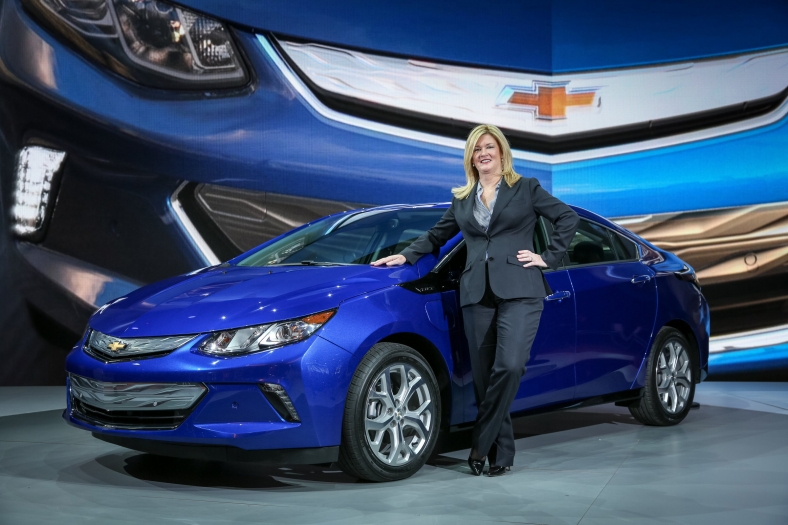March is Women’s History month. At Energy.gov we are highlighting the great contributions to science, technology, engineering and mathematics or STEM fields made by women throughout history, as well as highlighting the important work that women are doing in STEM fields today.
Pam Fletcher is the executive chief engineer for electric vehicles at General Motors, including Chevrolet’s plug-in electric car: the Volt. She spoke with Energy.gov about what inspired her to pursue a career in engineering and what she likes to do when she’s not working on cars.
The Energy Department collaborates with General Motors through U.S. DRIVE, a government-industry partnership focused on pre-competitive research and development into light-duty advanced technology vehicles and related infrastructure. General Motors is also a headline sponsor with the Energy Department of EcoCAR 3, an Advanced Vehicle Technology Competition that challenges 16 North American university teams to redesign a Chevrolet Camaro to reduce its environmental impact while maintaining its performance.
- What inspired you to work in vehicle engineering?
My dad had multiple motorsports hobbies when I was growing up. I think in the beginning he got me involved just because he needed an extra set of hands in the garage, but over time working with him and then going to the racetrack, just that adrenaline and excitement of the track on the weekends was something I really, really started to love.
So going into engineering, I wanted to keep perpetuating the fun and excitement that we’d had at home. I never changed my major or guessed at what my major was going to be; I had a pretty clear line of sight.
- How did you get to where you are in your career path?
At the time I went to GMI (now Kettering University), you had corporate sponsors. So you have a type of co-op experience, and my sponsor was McLaren, which had racing programs they were managing, as well as niche performance production cars. So that really, only further convinced me that I was able to continue the fun and the excitement of the racetrack in my career.
This was around the time when all of the electronic controls were coming into play on power-train transmissions, and I really liked that, but I knew that the real intellectual property in that space was owned by the automakers. So that’s when I went to work for GM.
- Why did you decide to start working on advanced vehicles?
In the beginning it was the technology to be honest. I like being on the forefront of what’s new. Everyone wants to work on things that are not only interesting and exciting, but also valued. So it couldn’t be more exciting.
- What is the most rewarding aspect of working on advanced vehicles?
No question: it’s surprising, delighting, and exceeding the expectations of our owners.
- What is your favorite feature of plug-in electric vehicles?
It’s the fun to drive part! You step on the accelerator and it’s instant go and when it accelerates it’s smooth, it’s quiet. I have two little nephews and when I go to see them they always say, “And you’re bringing the cool car, right?”
- What is a “day in the life” of GM’s executive chief engineer for electrified vehicles like?
I go anywhere from the proving grounds — where you’re actually driving and testing vehicles — to the design studio — where we’re trying to make them look beautiful — down to our assembly plant — where you can actually see the cars built. So it’s really pretty cool. People’s perception of what I do as an engineer is that I’m always under a car and that I must have grease under my nails. That’s all good, but it’s not the only thing we do!
- What is the best part about working in a STEM field?
Careers in science and math can be so rewarding, because everything in life has science behind it. Not only are they jobs that are in demand and challenging and, frankly, fairly well paying, but they can also be tremendously rewarding because you’re designing and developing things that change and improve people’s lives.
Literally everything you touch on a daily basis has science behind it — anything from cars to the cosmetic industry.
- Can you tell us about an experience where you’ve really gotten to see the difference you’ve made?
Every day people write to us about, particularly, their Volt and how it’s let them be gasoline-free for tens of thousands of miles. The ones that are the most satisfying and make me realize the responsibility of being a chief engineer are when people send pictures of their child or their family or their crashed car and say, “We survived thanks to the ability of the Volt.”
That’s a pretty big responsibility to hold, and we don’t take it lightly.
- What do you like to do when you’re not working?
I like to play tennis. I like to boat. I like to have dinner with my friends. I like to spend time with my husband, and not necessarily in that order!
- What advice do you have for young women interested in your field?
Number one, have confidence in your abilities. I think many women underestimate what they’re capable of. And then, don’t be afraid to ask questions and dig in the details so you can get a full understanding of whatever the problem is you’re trying to solve. And once you get that fundamental understanding, then you can start building a solution. Don’t be afraid to ask the clarifying questions, and just go for it!

